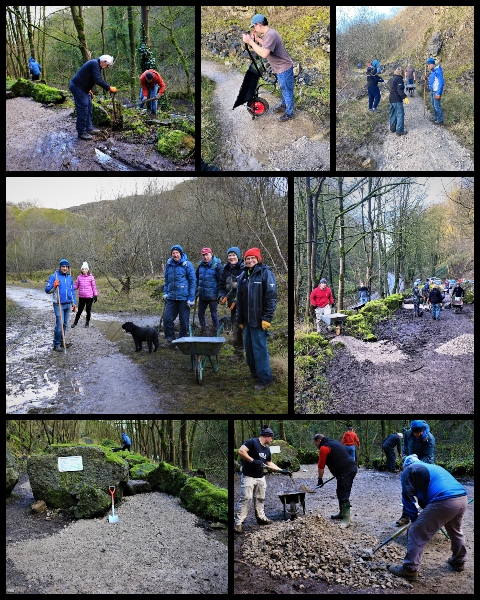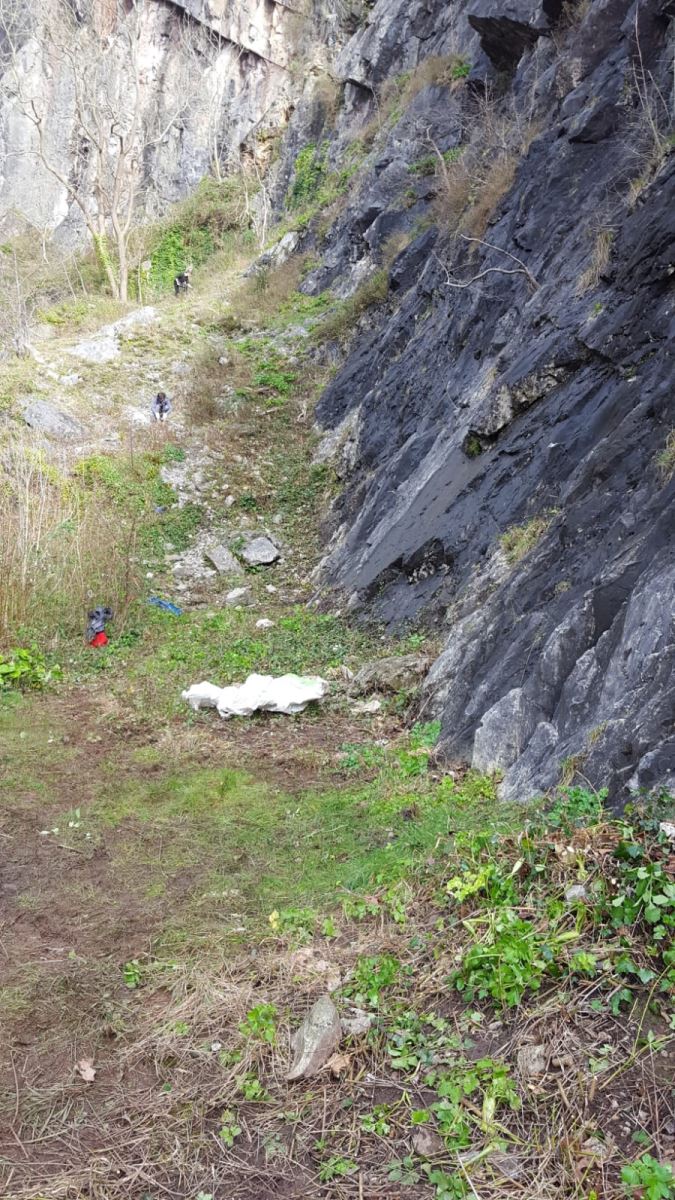We’re not even two months into the new decade, and already volunteers in the Peak District, South East and South West have been getting their hands dirty and helping to make improvements at their local crags. Here’s a look at what they have been up to and an opportunity for us to say a big thank you to all involved!
Horseshoe Quarry
Over the last few years the approach path at Horseshoe has been getting increasingly muddy and waterlogged, meaning visitors have to walk out to the side of the path to avoid wading. This increased erosion, widening the muddy areas and has been making access after rain a rather wet affair.
A collaboration between BMC volunteers and the Peak Park Conservation Volunteers provided an ideal opportunity to make some improvements to the track. Tarmac very kindly delivered a truck load of limestone aggregate free of charge to the car park on the morning of Saturday 18th January where over 30 keen volunteers were waiting.
Over the course of the morning the team dug drainage ditches to divert standing water away from the path, excavated muddy sections and refilled with aggregate which will drain better and provide a more durable surface, and cut back vegetation which was overgrowing the path.
The result is a much-improved access route into the quarry that blends into its surroundings well and should mean that wellies aren’t a mandatory rack item for anyone visiting in the winter months. A great job and fantastic effort from all involved!

Photos above: Horseshoe workday volunteers getting stuck into path repairs, improving drainage and cutting back vegetation overgrowing the path.
Harrisons Rocks
Over the weekend f 18th-19th January, the ever-proactive Sandstone Volunteers Group got stuck into the next phase of the Harrison’s Rocks woodland management plan. The aim of the plan is to thin out the canopy across Harrisons Rocks over a 13 year period, allowing the rocks to dry more quickly and stay in good condition whilst also giving space for new native species of tree to grow, hopefully resulting in a more biodiverse and resilient woodland in years to come.
The focus of work this year was on the area below The Vice, and as always for safety reasons the tree felling was undertaken in the week before the work days by professional tree surgeons. This left the timber and arisings to be cleared and utilised by the Sandstone Volunteers Group. The timber from felled trees makes great material to build revetments with along the base of the crag and on approach paths, all of which helps to slow downhill erosion of the sandy soil along areas of high use.
Once again it was a fantastic effort from these local volunteers, all helping to look after one of the most popular Southern Sandstone crags.
Avon Gorge
Originally planned to run on the 16th Feb, the annual Avon Bramble Bash was delayed by a week this year due to Storm Dennis. The following weekend on the 23rd Feb, 11 keen volunteers turned out despite a poor forecast and set to work removing invasive scrub around the base of Main Wall. This has the dual benefit of keeping access to the base of routes clear, but also removing invasive shrubs which shade out important rare native species.
Winter is the perfect time of year to do this work as wet weather tends to leave the crags empty and vegetation has died back over winter so there is less volume to deal with. In the Avon Gorge, the main focus is removing brambles and other invasive plants by hand. The Gorge is a SSSI with a number of rare plant species forming part of its designation, so local climber and botanist Libby Houston was on hand as ever to locate and mark any rare species of plant to be avoided.
The result of the volunteer’s work was clearance of scrub along the base of Morning Slab (home to classic routes such as Clarion, Mike’s Mistake, Reveille and more) and up the slope towards Dawn Walk. This has left a good clear area along the base of the crag for climbers and plants alike as can be seen in the after photo below (credit Jerzy Wieczorek).

Want to get involved?
Here are details of a few specific ways you can volunteer and get stuck into practical work in your local area…
Peak District
Over the last year or so the Peak Park Conservation Volunteers have also been helping us with conservation management work at Horseshoe through their volunteer workdays. The main focus at horseshoe has been to control trees and shrubs which are encroaching onto the ecologically important open grassland areas within the quarry and top land. They are a fantastic group of volunteers who carry out conservation work at sites around the National Park year-round. If you are interested in the work they do and potentially volunteering yourself, you can find out more on their website or social media:
Twitter:- @PeakPark_PPCV
Facebook:- @PPCV.PDNP
Instagram:- @ppcv_pdnp
Southern Sandstone
For anyone based in the South East, the Sandstone Volunteers Group are a fantastic bunch who organise a number of volunteer work days each year to keep southern sandstone crags in great condition. Work tends to focus around preventing erosion at the base of the crags by improving drainage and building revetments to stop material being washed away and lots more. Find out more about how to get involved here.
Local crag work days
Local BMC areas tend to run crag work days during the late autumn/winter/early spring when the weather tends to be too poor for climbing. These can be anything from general cleaning of routes to removing invasive species (like rhododendron) from the crag or even a simple litter pick at crags where this is an issue. Keep an eye out on your local BMC area social media pages for details of upcoming clean up days and how to get involved.
Hills 2 Oceans
Alongside this, our Hills 2 Oceans campaign continues to run, aiming to collect plastic and other waste and prevent it from being washed downstream and into the ocean. There are a number of events already being organised around the country which you can join, or you could even organise your own event. Full details here.
DOWNLOAD: the BMC RAD app
Get all the info on crags with the RAD (Regional Access Database) app from the BMC! Available now for Android and iOS, it's free and comes with a host of new features like navigation and parking, weather and tidal updates, and of course information on restrictions or notes on access advice. Get it here now!
RAD is community led and your comments help keep it up to date so don’t be afraid to add any relevant information after a crag visit which might be useful for other visitors – anything from conditions on the crag, favourite routes or reports of rockfall/other recent changes to the crag are all useful for other climbers visiting.
« Back